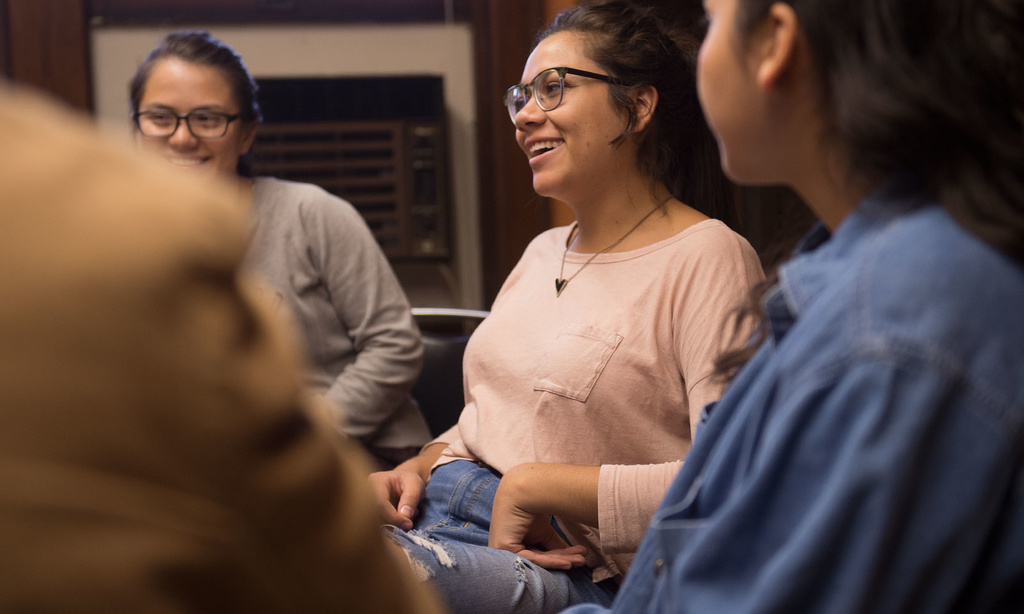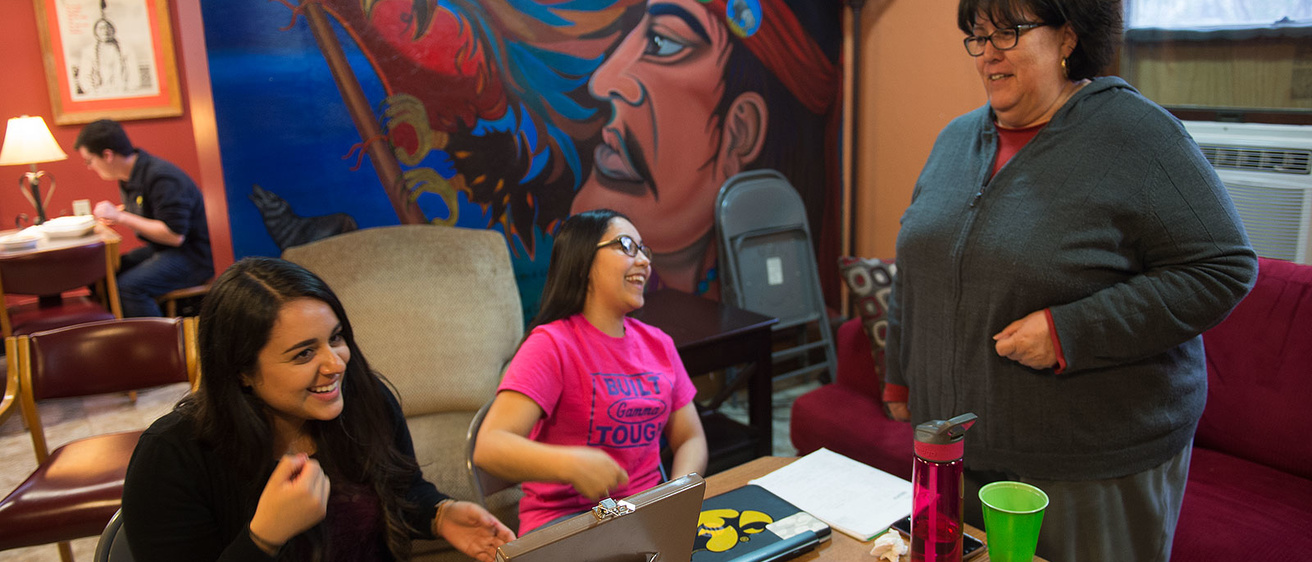On April 15, the Latino Native American Cultural Center (LNACC) will celebrate 45 years of serving and advocating on behalf of Latino and Native students. Peggy Valdés, graduate assistant manager of the center, says that the LNACC provides an invaluable service to the campus. “One of the greatest predictors of persistence and goal attainment is students gaining a sense of belonging,” she says.
Since Tony Zavala, Ruth Pushetonequa, and Nancy “Rusty” Barceló founded the center in 1971, it has been a hub for student groups, powwows, activism, outreach programs, conferences, support services, cultural events and publications, and student life.
It now stands as a testament to and an ongoing fulfillment of the University of Iowa’s core values of diversity, integrity, and community—values the LNACC has helped shape.
The Latino Native American Cultural Center’s 45th anniversary celebration will include remarks from alumni; speakers will include Brenda Child, the only Native American Ph.D. graduate from the UI history department, and Georgina Dodge, the university’s Chief Diversity Officer. The keynote speaker will be Nancy “Rusty” Barceló, who after founding LNACC went on to become assistant provost and interim director of opportunity at Iowa.
The center, originally named the Chicano Indian American Cultural Center, was in part a response to the assassination of Martin Luther King, Jr. in 1968. The assassination prompted then–UI President Howard Bowen’s public resolution to increase student diversity. Students founded the center three years later amid protests that Chicano and Native American recruitment was too low.
A popular assumption at the time was that minorities would assimilate into a common cultural experience, but LNACC founders endeavored to preserve their separate heritage and identity.
“The center was never meant to be a place for us to segregate ourselves. It was where we could be nourished among others like ourselves so that we might survive and contribute to the broader university community,” founder Barceló said at the time.
Founder Zavala remarked, “Sometimes culture is as necessary as food in order to survive.”
Concerns regarding identity, community, and minority enrollment dominated the center’s early years, along with demands that the university create formal Chicano studies courses and majors.
Some of those concerns have changed over time. Chicano studies, for example, is no longer a priority at the center. The university now offers a minor in Latina/Latino studies and will offer ten courses in the fall 2016 that satisfy that minor’s criteria.
“It's obvious that Latino and Native students are underrepresented on campus,” says Haley Henscheid, co-president of the Native American Student Association (NASA). “I think that Latino and Native students have a more difficult time adjusting to Iowa due to different cultural backgrounds, but I think—and hope—that it's very possible to find a welcoming community, especially with spaces like the LNACC.”

In fall 2015, the incoming class was the most diverse in the UI’s history. In the university as a whole, 16.6 percent of students self identified as a minority. Though less than one percent of UI students identify as Native American, 6.2 percent identify as Hispanic/Latino(a). This is higher than the 5.6 percent of Iowans self identified as Latino(a), according to the State Data Center of Iowa. In the Big Ten, only the University of Illinois and Northwestern University have a higher percentage of Hispanic students, according to Forbes.
Valdés says the university actively works to recruit Latino students in places like California and Texas, where student demand exceeds university-system capacity.
Henscheid recognizes the university’s efforts, but thinks more could be done, specifically by increasing communication with and support of the campus’ cultural centers, which include the African American Cultural Center, the Asian Pacific American Cultural Center, and the LGBTQ Resource Center.
NASA and four other student organizations use the LNACC regularly: the Association of Latinos Moving Ahead (ALMA), Sigma Lambda Gamma, Sigma Lambda Beta, and Lambda Theta Nu. These groups found a haven in the LNACC, share its fundamental goals, and have used it as a launching point for a variety of successful programs.
Among those initiatives is the growth of Sigma Lambda Gamma. Michi López, its vice president of finance and a second-year biochemistry major, says her sorority is the fastest-growing multi-cultural–based sorority in the nation, and the LNACC-based chapter started it all.
Brian Leal, a junior and the outgoing president of ALMA, says that one major misconception about Latinos is that they are all Mexican or they all speak Spanish. He says that a major service provided by ALMA and the LNACC is a safe place where Latinos of different backgrounds are included, nurtured, and encouraged to express and experience their varied identities through cultural events.
Aside from the academic and support services available, the need for community and a “sense of belonging” often draws students to the center. However, like Valdés, they might not have sought it out when they first arrived on campus or even recognized its absence.
“I had no idea how important it was,” she says. “I felt really kind of culturally isolated for that first year.”
A graduate student in the department of higher education and student affairs, Valdés had been conducting research at the UI for a year before she applied to work at the LNACC in order to gain direct experience working with students.
“When I switched here, I realized what I was missing,” says Valdés, reaching for a tissue. “I was missing people that looked and sounded like me.” She wipes her eyes and jokes, “I came here to help the students, but they probably helped me more than I helped them.”
A 2002 student task force on the UI’s cultural centers found that they helped meet the needs of minority students and thereby increased retention.
Many of the LNACC’s walls are painted with murals from previous students, a statement of identity and a reminder of the center’s history. When moving to 308 Melrose Ave. from its original location on North Clinton Street, the center retained its grand fireplace mantelpiece, and it remains standing in the center’s living room. Framed and hanging near the kitchen is a brief history outlining the center’s struggles and successes, written by Rachel Garza Carreón, an outreach and research librarian assigned to the LNACC.
“I think as long as students understand how important the house is and don’t take it for granted,” says Valdés, “we’ll be here for as long as there are Latino students here.”
A full slate of events
The 45th anniversary of the Latino Native American Cultural Center takes place from 5 to 8 p.m. Friday, April 15, at 308 Melrose Ave. and will include a rededication ceremony followed by a reception.
At 6 p.m. on April 14 at Art Building West, noted artist Bunky Echo-Hawk will create a new piece live, inspired in the moment by Brenda Child, UI graduate, who will be reading from her book My Grandfather’s Knocking Sticks. The resulting artwork will be gifted to the LNACC.
Honoring Native American dance, food, and rich traditions, the 22nd Annual UI Powwow will take place at the UI Field House from noon to 10 p.m. April 16.
For a full schedule of events, visit www.iowalum.com/LNACC/Schedule.cfm.
